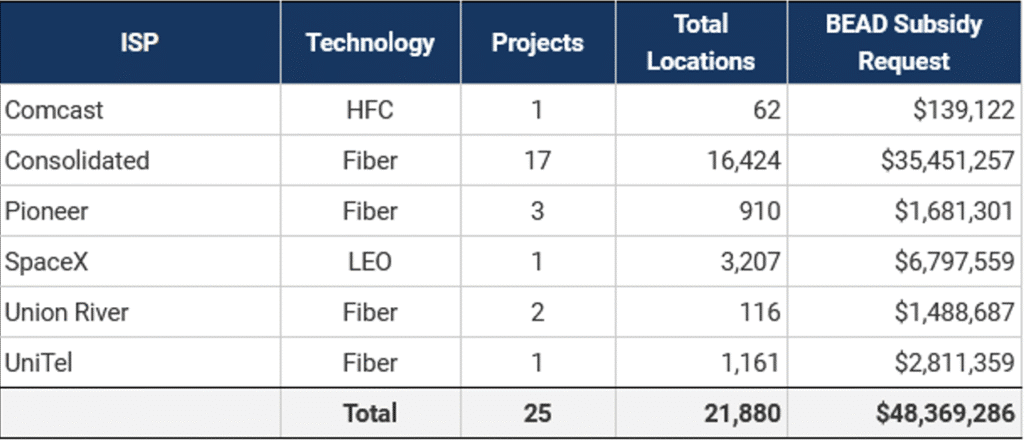Brian Allenby, chief operating officer for Maine Connectivity Authority (MCA), is optimistic about the state’s revised award recommendations in the Broadband Equity Access and Deployment (BEAD) Program.
“We’re hoping it will be the final awards list,” he told Telecompetitor in an interview last Friday.
The list, which MCA shared with Telecompetitor (see below), is almost the same as what the state sent to the National Telecommunications and Information Administration (NTIA) for approval prior to the September 4 deadline.
The main difference is that NTIA did not allow the state to award funding for certain locations. Maine said those locations should be eligible for broadband funding, but NTIA didn’t agree.
The award recommendations that MCA sent to NTIA totaled about $48.4 million. The revised awards list calls for the same amount of funding.
Making certain locations ineligible for funding “doesn’t materially change” the cost of a project, Allenby noted.

The NTIA Threshold
NTIA also has asked MCA to explain two award recommendations that were higher, on a per-location basis, than the others, Allenby told Telecompetitor.
When Telecompetitor asked Allenby if this was triggered by the caps that NTIA reportedly established for each state, he confirmed that the two Maine broadband awards exceeded NTIA’s threshold. That threshold, he said, was “not inconsistent with the data that has been released from other sources.”
But while some news reports said NTIA would tell the states to ask proposed awardees that exceeded the threshold for their best and final offer, MCA has not been told to do that. Instead, the state submitted a justification for the award amount.
Allenby is hopeful that NTIA will be satisfied with the information submitted.
“We haven’t heard anything back that would lead us to believe [the awards] won’t be funded,” Allenby said.
It’s worth noting that NTIA may be considering how much a proposed award exceeds the threshold in determining its response to each state. In other words, the “best and final offer” approach may apply in some cases, while the agency may simply ask for more information in other cases.
The Benefit of the Bargain
When NTIA imposed changes to the BEAD program back in June, MCA had already conducted an application process under the initial rules but had not yet announced award recommendations.
The evaluation process was put on hold, and a second round of applications was accepted based on the new rules. The award recommendations sent to NTIA in time for the September 4 deadline were based on the second round, commonly known as the Benefit of the Bargain round.
The new rules eliminated the initial preference for fiber. Nevertheless, the percentage of locations targeted to receive fiber broadband increased. Initially, about 75% to 80% of funded locations would have gotten fiber. That increased to 85% in the Benefit of the Bargain round.
This is particularly interesting, considering that two low Earth orbit (LEO) satellite broadband providers that didn’t participate in the initial round did apply in the Benefit of the Bargain round.
Allenby’s take on this: “We saw very competitive bidding in the second round,” he said. “The ISPs really showed up.”
He noted, for example, that, on average, Maine’s providers committed to covering 69% of broadband project costs. That’s almost three times the amount of matching funds that awardees are required to contribute.
Only one provider that bid in the first round opted not to participate in the second round — a result that Allenby attributes, at least in part, to MCA’s constant contact with initial applicants.
“We encouraged them to come back and did everything we could to maintain those relationships,” he said.
Non-Deployment Funds
If indeed NTIA approves Maine’s BEAD funding based on MCA’s latest awards list, the total amount of broadband funding will be only about 18% of the $272 million in BEAD deployment funding that was initially allocated to the state back in 2023.
The fate of any unawarded funding is a hot issue right now across all 50 states. The legislation that established the BEAD program enables the funding to be used for certain non-deployment purposes such as workforce development and connectivity to anchor institutions. But whether NTIA will proceed with that approach remains unclear.
Allenby is optimistic about this, too.
Noting that MCA has been in touch with NTIA and other states about this, he said, “We remain hopeful. We want to look at uses that will align both with the state’s priorities and certainly with the administration’s priorities as well.”
Additional information about Maine broadband, including links to state funding resources, BEAD news, grants made, state-specific Telecompetitor coverage, and more can be found on the Broadband Nation webpage for the state.



